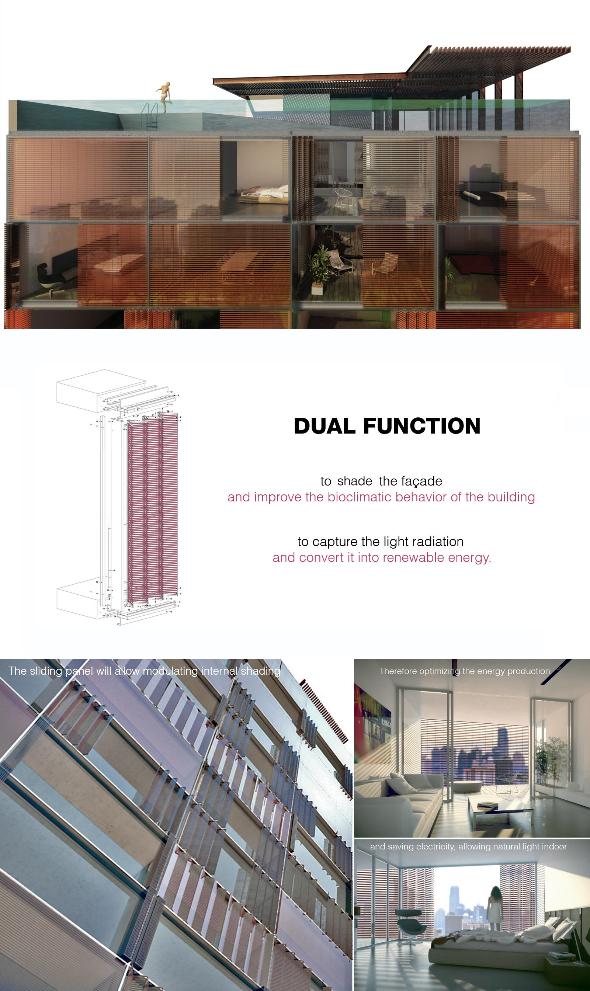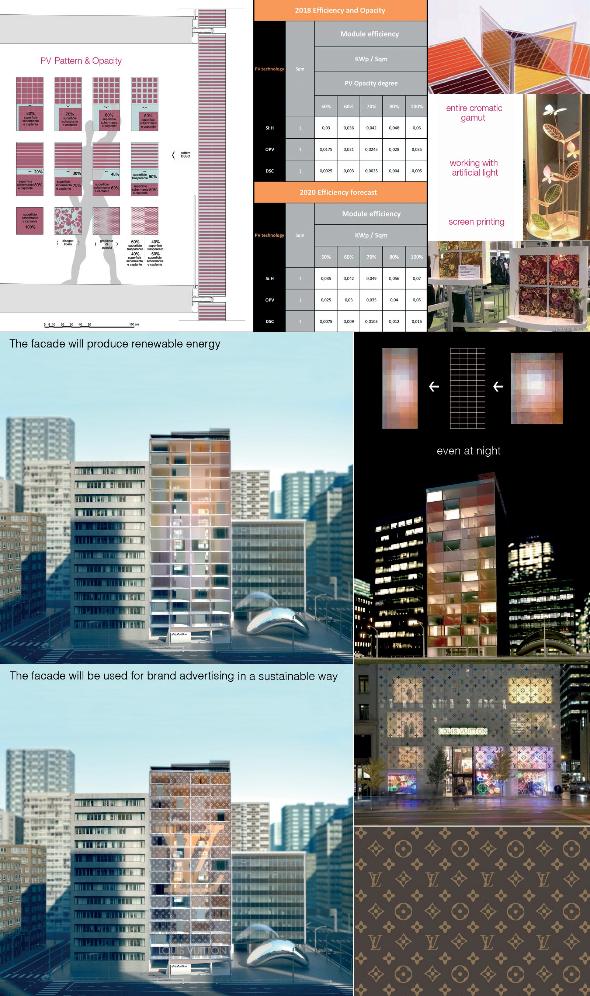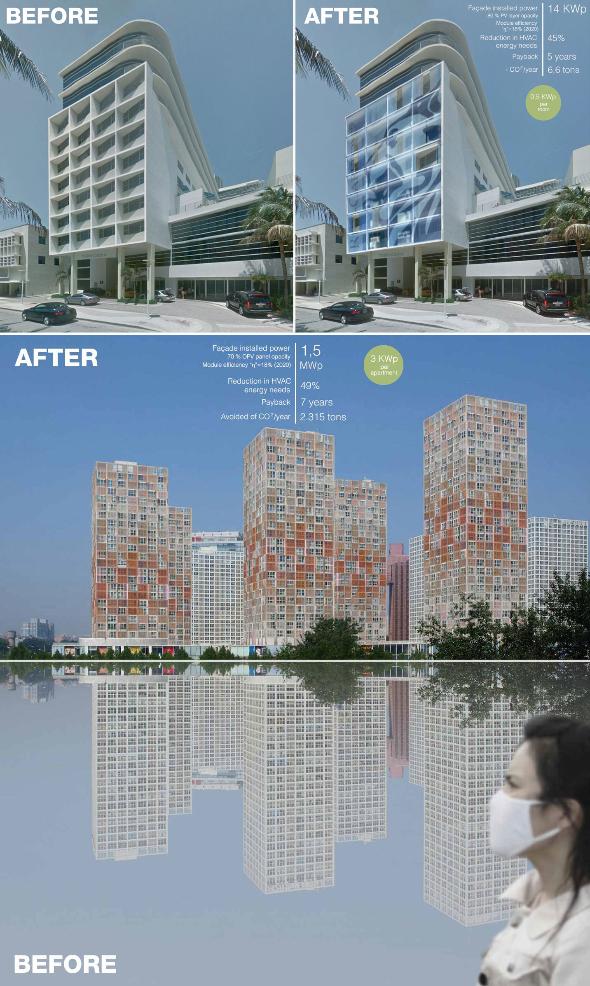International Partner Search
Innovation & Technology Offer
Innovative and patented adaptive photovoltaic facade system
Country of Origin: Italy
Reference Number: TOIT20180905002
Publication Date: 6 September 2018
Summary
An Italian architecture company has developed and patented a façade system that allows the designing of new and efficient buildings and the energy renovation or conversion of the whole or part of existing ones, while responding to net Zero Energy Building (nZEB) requirements and drastically reducing the Green House Gas (GHG) emissions. The company is looking for different funding opportunities to start the development phase of the system.
Description
Climate Change is a phenomenon of global magnitude experienced locally by people, in different contexts and in different ways. This warming phenomenon is particularly manifest in towns where it is amplified by localized anthropogenic heat generated by urban metabolic processes.
Buildings anywhere in the world have major roles to play in environmental sustainability, they are responsible for 40% of global energy consumption. In fact, 60% of the operational energy of a typical building goes to cooling and heating, particularly in high-rise buildings much more energy intensive, especially if they have a glass curtain wall without shading system. Between 40 and 70% of the global Green House Gas (GHG) emissions are generated in towns and the combined effect of GHG emissions produced in and for the town, induce a localized warming UHI effect (Urban Heat Island effect) at a rate much higher than that of the global warming alone.
This is why buildings offer the greatest potential for reducing GHG emissions. The worldwide research in the evolution processes of the building’s envelope, is currently addressing efforts in two distinct directions: on the one hand, lowering building energy consumption needs, through the use of dynamic and adaptive envelope systems with better performances to improve the bioclimatic behavior of the building; and on the other hand, targeting the architectural integration of renewable energy systems.
Therefore, BIPV (Building Integrated Photo Voltaic) systems are of primary need. Through these systems, any building can be transformed into a "small generation plant" that produces clean and renewable energy to satisfy its own needs, re-entering any surplus in a "smart grid" that will be the backbone of the new circular-economy.
The conceptual approach of this innovative system is to respond to these challenges conceiving a façade system that performs these different functions (shading, BIPV, natural ventilations), efficiently and simultaneously, thus reducing construction costs and halving the time of investment recoup.
This patented system combines the single characteristics and unites the benefits of two existing separate facade system types (fixed BIPV and shading systems) already available on the market, overcoming their relative disadvantages when used individually.
It is composed of sliding and folding PV panels that have a dual function: on the one hand to shade, with the opacity of PV layer, the façade from sunlight exposure and improve the bio-climatic behavior of the building; on the other to capture the light radiation and convert it into renewable energy.
The ability of the system to adapt (through the use of building automation systems) in real time to all kind of weather conditions, allows the building to optimize its bioclimatic behavior and the production of renewable energy to satisfy its energy needs, responding to nZEB requirements and drastically reducing GHG emissions.
It will then be possible for each building to produce renewable energy and to exchange any available energy surplus with other buildings reducing, at the same time, the CO2 emissions.
The system is able to reduce the load of cooling/heating systems that contribute to the raising of the building's energy needs and the consequent raising of the temperature levels of its surrounding public spaces Urban (UHI).
In the near future the PV’s growing efficiency levels and the reduction of the average daily energy consumption per user will contribute to the generation of a renewable energy production surplus that will guarantee capital gains.
The company is looking for different funding opportunities to start the development phase of the system and to demonstrate its replicability.
Different types of partnerships (commercial agreements with technical assistance, financial, license or manufacturing agreements joint venture or research cooperation agreements) are sought.



Advantages and Innovations
The product’s main objective is to overcome the disadvantages of the façade systems available on the market: “adaptive shading systems” and “fixed BIPV (Building Integrated Photo Voltaic) systems”, responding efficiently and simultaneously to two different functions through the sliding and folding movement of its PV panel groups, improving the versatility of their use.
The movable PV panels have an important “dual function”: on one hand, with the opacity of the PV layer, “to shade” the façade from sunlight exposure and improve the bioclimatic behavior of the building; on the other, the same layer allows “to capture” the light radiation, weather conditions permitting, and convert it into renewable energy.
The use of this system on new or existing buildings will allow:
- to improve the natural ventilation and to reduce the cooling/heating systems loads, reducing the energy needs of the building.
- to adapt in real time and to optimize the production of energy and energy needs.
- to shade the façade and to improve the bioclimatic behavior of the building
- to combine the functions associated with two different types of facade systems and to overcome their respective disadvantages with only one façade system.
- to overcome the limit of the existing Shading systems that only shade the façade and cannot capture light radiation
- to overcome the disadvantages of the existing fixed BIPV systems, which in unfavorable weather conditions (overcast) do not produce energy and induce the use of artificial light to illuminate the interior spaces during daylight hours.
Although the system works with all kinds of photovoltaic panels already available on the market, it offers high aesthetic values when using the third generation OPV (Organic Photovoltaic), DSC (Dye Sensitized Solar Cells) and a:Si (Amorphous silicon) thing film technology; it's possible to design the PV layer (opacity and patterns) placed between two transparent substrates of one single panel.
Stage Of Development
Concept stage
Requested partner
Commercial agreement with technical assistance:
The company is looking for potential customers (Builders, Multinationals, Private) interested in using the product through an important pilot project in order to launch the product on the international market. The product can be even used on existing buildings to realize restyling, retrofitting and energy efficiency operations.
Financial agreement:
The company is looking for European and private funding to start the development and prototyping of the product.
Joint venture agreement:
The transversality of the product requires the union of different skills to make it and distribute it.
In this regard, it is necessary to set up a Consortium that includes different companies specialized in different sectors:
1) General contractor, to distribute the product on the international market.
2) Specialized company in R&D e production of PV panels.
3) Specialized company to engineering and R&D of movable façade systems.
4) Specialized company in building automation systems.
License agreement:
The company is looking for general contractors to distribute the product in different market areas through various licenses for exclusive use for macro areas and for a fixed period, based on license agreements both on fixed and variable royalties.
Manufacturing agreement:
The company is looking for companies specialized in different sectors to prototype, manufacturing, test and certify the product, which being a transversal product needs more skills to be able to produce an innovative and complete product:
1) Company specialized in R&D and production of PV panels in a:Si Thin-film and with third-generation PV technologies (DSC, OPV) and that it is able to provide a wide selection of transparent substrates (even towards their internal partnerships) to be used for individual panels.
2) Company specialized in the engineering and manufacturing of movable façade systems (specifically with experience in sliding and folding facade systems)
3) Company specialized in Building automation systems.
The company should be structured to be able to cover (even towards their internal partnerships) both the software and hardware components of the system (with sensors and actuators to be incorporated into the system);
Research cooperation agreement:
The company is looking for research institutes that collaborate in the development and prototyping of the product. These institutes must be able to carry out R & D in the fields: photovoltaics, simulation, tests, certifications and guarantee the achievement of the requirements required by the product.
Cooperation offer is closed for requests
